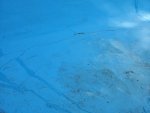I have a gunite pool and wanted to know if you could put a sealer on it, like sealer for a shower floor.
gunite
- Thread starter TonyTonyTony
- Start date
You are using an out of date browser. It may not display this or other websites correctly.
You should upgrade or use an alternative browser.
You should upgrade or use an alternative browser.
- Jul 17, 2019
- 3,714
- Pool Size
- 13000
- Surface
- Plaster
- Chlorine
- Salt Water Generator
- SWG Type
- Pentair Intellichlor IC-40
That would certainly not be the norm. What are you trying to do? Gunite is the "bones" of a pool, but it is covered by a plaster/pebble/quartz finish that lasts 10-20 years. Has your finish worn through?
The plaster (2 layers) was pulling away from the wall. I was advised by pool company to take the plaster off, and paint with appoxy paint, which is what I have done.
I believe the pool leaks, with or without plaster or appoxy paint. I am trying to fix leak
I believe the pool leaks, with or without plaster or appoxy paint. I am trying to fix leak
The plaster (2 layers) was pulling away from the wall. I was advised by pool company to take the plaster off, and paint with appoxy paint, which is what I have done.That would certainly not be the norm. What are you trying to do? Gunite is the "bones" of a pool, but it is covered by a plaster/pebble/quartz finish that lasts 10-20 years. Has your finish worn through?
I believe the pool leaks, with or without plaster or appoxy paint. I am trying to fiX leak
Ohhhh Tony, Tony, Tony <can ya hear this Italian Momma's angst??>
Gunnite isn't waterproof. Never was. I doubt paint will make it so either. Its the plaster finish that seals the pool up.
Let me invite some expert pool builders in for their input, k? @jimmythegreek @bdavis466
@onBalance
Maddie
Gunnite isn't waterproof. Never was. I doubt paint will make it so either. Its the plaster finish that seals the pool up.
Let me invite some expert pool builders in for their input, k? @jimmythegreek @bdavis466
@onBalance
Maddie
They gave you horrible advice. Pool paint doeant last long and is a bandaid at best. It's a pain to remove to do a correct plaster job its never a good solution. If the pool is leaking its probably from a fitting at face of pool or plumbing leaks.
They gave you horrible advice. Pool paint doeant last long and is a bandaid at best. It's a pain to remove to do a correct plaster job its never a good solution. If the pool is leaking its probably from a fitting at face of pool or plumbing leaks.
What do mean face of pool? I am now trying to clean up the pool, so I can sell the house. I am in the process of draining the pool, and tomorrow pressure wash, then fill it back up, and try to keep it looking good until sell. While the pool is empty what should I look for? I think there maybe a leak around the light. What should I use to seal? How do you remove paint if I want to plaster it?
You need pool sealant its basically silicone that's rated for u underwater use. To plaster it you would sandblast the paint off amd then bondcoat first then plaster
You need pool sealant its basically silicone that's rated for u underwater use. To plaster it you would sandblast the paint off amd then bondcoat first then plaster
Attachments
I am attaching pics for you. Got the water drained out, debris cleaned out, and pressure washed. There was a crack in there the size of the grand canyon. What should I do to repair something like this?
- Jul 21, 2013
- 52,508
- Pool Size
- 35000
- Surface
- Plaster
- Chlorine
- Salt Water Generator
- SWG Type
- Pentair Intellichlor IC-60
That pool needs to be replastered.
If you paint it then you are hoping you get an uneducated buyer who does not do a pool inspection and will not be happy discovering what they really bought.
If you paint it then you are hoping you get an uneducated buyer who does not do a pool inspection and will not be happy discovering what they really bought.
I would like to repair the cracks before putting plaster over them. Any idea how to repair the cracks?That pool needs to be replastered.
If you paint it then you are hoping you get an uneducated buyer who does not do a pool inspection and will not be happy discovering what they really bought.
Put the house on the market with a kickback towards a new plaster job. Then the new buyers can pick out their own plaster finish/color.
Maddie
Maddie
- Jul 21, 2013
- 52,508
- Pool Size
- 35000
- Surface
- Plaster
- Chlorine
- Salt Water Generator
- SWG Type
- Pentair Intellichlor IC-60
I would like to repair the cracks before putting plaster over them. Any idea how to repair the cracks?
You don’t put new plaster over plaster that is cracked, delaminating, and does not have good adhesion to the gunite. The plaster needs to be removed down to a solid surface and new plaster applied.
Either fix it right or sell the house with the pool as is.
We see home buyers coming here after finding surprises in the problems with pools that were not properly disclosed. There are many shady seller practices that try to hide known problems. Don’t be one of those sellers.
You don’t put new plaster over plaster that is cracked, delaminating, and does not have good adhesion to the gunite. The plaster needs to be removed down to a solid surface and new plaster applied.
Either fix it right or sell the house with the pool as is.
We see home buyers coming here after finding surprises in the problems with pools that were not properly disclosed. There are many shady seller practices that try to hide known problems. Don’t be one of those sellers.
[/QUOT
The pool doesn't have plaster on it. I am trying not to be, as you say, one of those sellers.
- Jul 21, 2013
- 52,508
- Pool Size
- 35000
- Surface
- Plaster
- Chlorine
- Salt Water Generator
- SWG Type
- Pentair Intellichlor IC-60
The pool doesn't have plaster on it. I am trying not to be, as you say, one of those sellers.
It is either plaster that is cracked or the gunite shell itself is cracked. I can't tell from the pictures you posted.
If the gunite is cracked then you have bigger structural issues. You may need concrete staples with epoxy injection for a mechanical solid fix. This is a common concrete repair technique.
Watch
Torque Lock
Concrete Crack Repair Staples for Swimming Pools and Pool Decks | AquaStitch
Pool Structural Repair Staples. Carbon Fiber Kevlar Repair by Fortress Stabilization
I have been talking to a construction man about the pool. He suggested cutting out the large cracks, and usng hydrolic cement to fill it in. Do you see any problems with this?You need pool sealant its basically silicone that's rated for u underwater use. To plaster it you would sandblast the paint off amd then bondcoat first then plaster
That seems like alot of work for hairline cracks, and potentially making them worse.It is either plaster that is cracked or the gunite shell itself is cracked. I can't tell from the pictures you posted.
If the gunite is cracked then you have bigger structural issues. You may need concrete staples with epoxy injection for a mechanical solid fix. This is a common concrete repair technique.
Watch
Torque Lock
Concrete Crack Repair Staples for Swimming Pools and Pool Decks | AquaStitch
Pool Structural Repair Staples. Carbon Fiber Kevlar Repair by Fortress Stabilization
I have been talking to a construction man
He suggested cutting out the large cracks, and usng hydrolic cement to fill it in. Do you see any problems with this?
- Jul 21, 2013
- 52,508
- Pool Size
- 35000
- Surface
- Plaster
- Chlorine
- Salt Water Generator
- SWG Type
- Pentair Intellichlor IC-60
That seems like alot of work for hairline cracks, and potentially making them worse.
I have been talking to a construction man
He suggested cutting out the large cracks, and usng hydrolic cement to fill it in. Do you see any problems with this?
You are then treating the symptom with putting hydraulic cement in the cracks and not the disease and the cracks are likely to return. The gunite has structural issues that caused it to crack. Hydraulic cement does not add any structure to the pool and it will crack again in time. Concrete staples fix the structural problems.
Using the hydraulic cement is a patch job that will bite a future owner when their pool develops cracks and they have no clue why. If youa re in a state where there are seller discclosure laws you would be required to disclose to a buyer that you are aware the pool had structural cracks and how you repaired it.
I was told by a geologist that having hairline cracks is common in my part of the country.You are then treating the symptom with putting hydraulic cement in the cracks and not the disease and the cracks are likely to return. The gunite has structural issues that caused it to crack. Hydraulic cement does not add any structure to the pool and it will crack again in time. Concrete staples fix the structural problems.
Using the hydraulic cement is a patch job that will bite a future owner when their pool develops cracks and they have no clue why. If youa re in a state where there are seller discclosure laws you would be required to disclose to a buyer that you are aware the pool had structural cracks and how you repaired it.
Thread Status
Hello , This thread has been inactive for over 60 days. New postings here are unlikely to be seen or responded to by other members. For better visibility, consider Starting A New Thread.
Similar threads
- Replies
- 7
- Views
- 352
- Replies
- 1
- Views
- 146
- Replies
- 20
- Views
- 315






